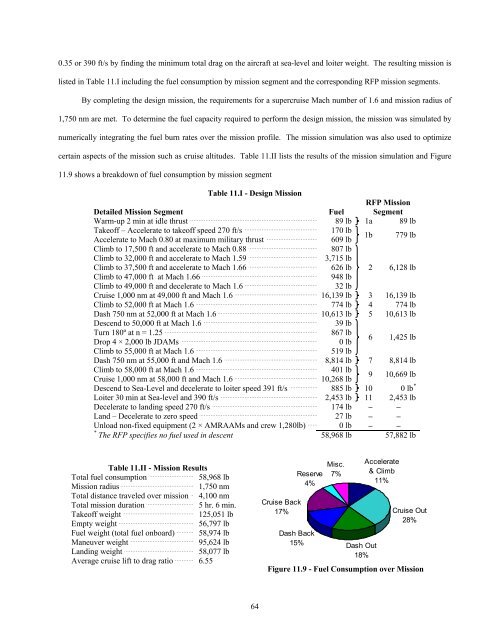Vendetta Final Proposal Part 2 - Cal Poly
Vendetta Final Proposal Part 2 - Cal Poly
Vendetta Final Proposal Part 2 - Cal Poly
Create successful ePaper yourself
Turn your PDF publications into a flip-book with our unique Google optimized e-Paper software.
0.35 or 390 ft/s by finding the minimum total drag on the aircraft at sea-level and loiter weight. The resulting mission is<br />
listed in Table 11.I including the fuel consumption by mission segment and the corresponding RFP mission segments.<br />
By completing the design mission, the requirements for a supercruise Mach number of 1.6 and mission radius of<br />
1,750 nm are met. To determine the fuel capacity required to perform the design mission, the mission was simulated by<br />
numerically integrating the fuel burn rates over the mission profile. The mission simulation was also used to optimize<br />
certain aspects of the mission such as cruise altitudes. Table 11.II lists the results of the mission simulation and Figure<br />
11.9 shows a breakdown of fuel consumption by mission segment<br />
Table 11.I - Design Mission<br />
Detailed Mission Segment<br />
Fuel<br />
RFP Mission<br />
Segment<br />
Warm-up 2 min at idle thrust 89 lb 1a 89 lb<br />
Takeoff – Accelerate to takeoff speed 270 ft/s<br />
170 lb<br />
Accelerate to Mach 0.80 at maximum military thrust<br />
609 lb<br />
1b 779 lb<br />
Climb to 17,500 ft and accelerate to Mach 0.88<br />
807 lb<br />
Climb to 32,000 ft and accelerate to Mach 1.59<br />
3,715 lb<br />
Climb to 37,500 ft and accelerate to Mach 1.66<br />
626 lb 2 6,128 lb<br />
Climb to 47,000 ft at Mach 1.66<br />
948 lb<br />
Climb to 49,000 ft and decelerate to Mach 1.6<br />
32 lb<br />
Cruise 1,000 nm at 49,000 ft and Mach 1.6 16,139 lb 3 16,139 lb<br />
Climb to 52,000 ft at Mach 1.6 774 lb 4 774 lb<br />
Dash 750 nm at 52,000 ft at Mach 1.6 10,613 lb 5 10,613 lb<br />
Descend to 50,000 ft at Mach 1.6<br />
39 lb<br />
Turn 180º at n = 1.25<br />
867 lb<br />
Drop 4 × 2,000 lb JDAMs<br />
0 lb<br />
6 1,425 lb<br />
Climb to 55,000 ft at Mach 1.6<br />
519 lb<br />
Dash 750 nm at 55,000 ft and Mach 1.6 8,814 lb 7 8,814 lb<br />
Climb to 58,000 ft at Mach 1.6<br />
401 lb<br />
Cruise 1,000 nm at 58,000 ft and Mach 1.6<br />
10,268 lb<br />
9 10,669 lb<br />
Descend to Sea-Level and decelerate to loiter speed 391 ft/s 885 lb 10 0 lb *<br />
Loiter 30 min at Sea-level and 390 ft/s 2,453 lb 11 2,453 lb<br />
Decelerate to landing speed 270 ft/s 174 lb – –<br />
Land – Decelerate to zero speed 27 lb – –<br />
Unload non-fixed equipment (2 × AMRAAMs and crew 1,280lb) 0 lb – –<br />
* The RFP specifies no fuel used in descent 58,968 lb 57,882 lb<br />
Table 11.II - Mission Results<br />
Total fuel consumption<br />
58,968 lb<br />
Mission radius<br />
1,750 nm<br />
Total distance traveled over mission 4,100 nm<br />
Total mission duration<br />
5 hr. 6 min.<br />
Takeoff weight<br />
125,051 lb<br />
Empty weight<br />
56,797 lb<br />
Fuel weight (total fuel onboard) 58,974 lb<br />
Maneuver weight<br />
95,624 lb<br />
Landing weight<br />
58,077 lb<br />
Average cruise lift to drag ratio 6.55<br />
Cruise Back<br />
17%<br />
Reserve<br />
4%<br />
Dash Back<br />
15%<br />
Misc.<br />
7%<br />
Dash Out<br />
18%<br />
Accelerate<br />
& Climb<br />
11%<br />
Cruise Out<br />
28%<br />
Figure 11.9 - Fuel Consumption over Mission<br />
64













